Mutant pigweed, Amaranthus palmeri, caused by repeated application of Roundup to cotton. Pictures by Gretchen Quarterman, Coffee County, Georgia, 2 October 2010. More in the flickr set.
Tag Archives: pigweed
2,4-D: Back to the Past
Pour pesticides on crops until they breed more mutant superweeds.
So what is our old friend 2,4-D, which used to be commonly used back in the 1980s? Continue reading
Managing the Seedbank by Plowing
About pigweed, Georgia Extension weed scientist Dr. Stanley Culpepper says:
Economic survival will depend on managing the seedbank!!!!That’s on page 30 of a 46 page presentation at the 2010 Beltwide – Consultants Conference, after discussing how rapidly Roundup-Ready seeds have been adopted:
And how the value of advice on weed control during that period rapidly decreased as a direct correlation: Continue reading
Pigweed: don’t let it come up
 So is it just a few people’s opinion that
plowing works much better than herbicides to control mutant pigweed?
So is it just a few people’s opinion that
plowing works much better than herbicides to control mutant pigweed?
Henry Gantz writes in Don’t Give Pigweed The Light Of Day, If it doesn’t come up, you don’t have to kill it that farmers were depending mostly on Roundup, but that no longer works, due to multiple mutant weeds, including pigweed and marestail. He quotes Dr. Larry Steckle, Extension weed specialist at the University of Tennessee:
Steckle said we’ve now reached the point where we have to begin thinking in terms of controlling “resistant weeds” instead of “resistant marestail” or “resistant Palmer pigweed” because they are both beginning to show up in the same field.So, what’s the solution: Continue reading“We have to manage them both,” he said. “There’s a new product from BASF called Sharpen that I’ve been looking at for five years and I’ve been very impressed with the marestail control. I still like dicamba, Roundup and Gramoxone.
“But if you have Palmer pigweed, too, then you’re going to have to overlap with residuals ― Cotoran, Caparol, Prowl ― to have any chance to do a good job of controlling them.”
Deep-Till: Back to the Future of Plowing
 Roy Roberson writes in Farm Press about
http://southeastfarmpress.com/cotton/herbicide-resistance-0525/:
Roy Roberson writes in Farm Press about
http://southeastfarmpress.com/cotton/herbicide-resistance-0525/:
Deep tilling of crop land pocked and rutted by heavy equipment used on rain and snow soaked, often frozen farm land may not only clean up the land, but may have a significant positive effect on managing herbicide resistant weeds, especially Palmer pigweed.Back to the future! “Deep tilling” is the current buzzword for plowing. That’s how my father farmed, with a bottom plow, a subsoiler, a harrow, and a cultivator.
The same article continues to defend no-till:
There is no doubt about the many benefits of minimum or no-till cropping systems. Reduced-tillage saves farmers money in equipment, improves soil quality, improves the environment by making the soil more porous and produces better drainage. The list of benefits goes on and on.Promotes more erosion, is my observation. And how does no-till save farmers money if they have to pay for increasing amounts of pesticides to try to deal with mutant weeds like pigweed? Continue reading
Cultivating Organic Peanuts
Note the cultivator. The host had to explain what it was and show it several times so people would understand it. Yes, that’s how farmers used to control weeds before pesticide vendor propaganda convinced people of things like “don’t throw dirt on peanuts.” The cultivator throws dirt on weeds next to the peanuts, thus suppressing the weeds and releasing the peanuts.
Gretchen remarks:
Organic growing isn’t a specialty market, it’s a matter of safety. Chemicals sprayed on peanuts, soy beans, cotton and corn are TOXIC. Good management and kindness to the earth can grow crops in a sustainable way. Just say no to chemical spraying.Peanut growers may not like manual labor, but they’re having to resort to that anyway, because their pesticides have produced the mutant pigweed, which pesticides don’t kill. Spraying more and different herbicides doesn’t do it, either. The only way is physical removal of the pigweed. And a cultivator can do that without manual labor (the report mentions that). Oh yeah: and you don’t have to pay for pesticides to apply with a cultivator.
So, it’s time to stop poisoning our air, water, plants, animals, and people and move away from petrochemical pesticides. Organic is the way to go, and we know how to get there.
-jsq
Monsanto Price Drop
I think that’s CEO-speak for demand is down, competition is up, and Monsanto is retrenching in hopes of saving its core glysophate business. So sad.ST. LOUIS, May 27, 2010 /PRNewswire-FirstCall/ — Monsanto Company (NYSE:MON – News) today announced it is repositioning its Roundup® business in the face of fundamental structural changes that have caused upheaval in the glyphosate industry. Focusing its glyphosate products on supporting the core seeds-and-traits business, the company plans to drastically narrow its Roundup® brand portfolio to offer farmers a simple, quality product that meets their needs at a price closer to generics.
“By reducing the uncertainty associated with Roundup, we free Monsanto to grow on its fundamentals,” Chairman and Chief Executive Officer Hugh Grant said. “What matters to our long-term growth is our seeds-and-traits business, which is on track.”
More clarification from the CEO: Continue reading
Farmers Tired of Monsanto?
Low commodity soybean prices, attractive premiums, and rising prices for genetically modified soybean seed are leading American farmers to plant more acres of non-GMO soybeans this year.It seems Monsanto may be pricing itself out of its own market:Representatives with soybean associations, universities, and grain buyers all say that demand for non-GMO soybeans is growing, leading to more non-GMO acres.
Besides the higher non-GMO premiums, there are other reasons for the increasing acreage of non-GMO this year. One is lower cost. “The Roundup Ready system is not as cheap as it used to be,” Shannon says.And organic demand is having an effect:The cost for Monsanto’s Roundup Ready GM soybean seeds has increased from $35 to $50 per bag while the cost for Roundup herbicide has increased from $15 to $50 per gallon. “A lot of farmers are upset with Monsanto,” Shannon says.
The organic food industry is also spurring demand for non-GMO soybeans, says Craig Tomera, production agronomist/crop production manager at Northland Organic Foods. “Organic food companies are switching to non-GMO soybeans until prices for organics drop and the economy improves.”All that and mutant pigweed that Roundup doesn’t kill. So without even considering externalities (such as mutated frogs and human birth defects), it may be becoming less cost-effective for farmers to buy Monsanto. So sad.
Mutant Pigweed vs. Glysophate-Resistant Corn, Soybeans, and Cotton
 It’s a funny thing about monocultures. They’re highly vulnerable to anything
that affects that particular variety.
Dr. Mae-Wan Ho writes:
It’s a funny thing about monocultures. They’re highly vulnerable to anything
that affects that particular variety.
Dr. Mae-Wan Ho writes:
The scene is set at harvest time in Arkansas October 2009. Grim-faced farmers and scientists speak from fields infested with giant pigweed plants that can withstand as much glyphosate herbicide as you can afford to douse on them. One farmer spent US$0.5 million in three months trying to clear the monster weeds in vain; they stop combine harvesters and break hand tools. Already, an estimated one million acres of soybean and cotton crops in Arkansas have become infested.The palmer amaranth or palmer pigweed is the most dreaded weed. It can grow 7-8 feet tall, withstand withering heat and prolonged droughts, produce thousands of seeds and has a root system that drains nutrients away from crops. If left unchecked, it would take over a field in a year.
Meanwhile in North Carolina Perquimans County, farmer and extension worker Paul Smith has just found the offending weed in his field [3], and he too, will have to hire a migrant crew to remove the weed by hand.
Here’s the good news: Continue reading
Glysophate (Monsanto’s RoundUp) Causes Birth Defects: Argentine Scientist
 According to
Americas Program Report:
According to
Americas Program Report:
A study released by an Argentine scientist earlier this year reports that glyphosate, patented by Monsanto under the name “Round Up,” causes birth defects when applied in doses much lower than what is commonly used in soy fields.Why should Argentina care? Continue readingThe study was directed by a leading embryologist, Dr. Andres Carrasco, a professor and researcher at the University of Buenos Aires. In his office in the nation’s top medical school, Dr. Carrasco shows me the results of the study, pulling out photos of birth defects in the embryos of frog amphibians exposed to glyphosate. The frog embryos grown in petri dishes in the photos looked like something from a futuristic horror film, creatures with visible defects—one eye the size of the head, spinal cord deformations, and kidneys that are not fully developed.
“We injected the amphibian embryo cells with glyphosate diluted to a concentration 1,500 times [less] than what is used commercially and we allowed the amphibians to grow in strictly controlled conditions.” Dr. Carrasco reports that the embryos survived from a fertilized egg state until the tadpole stage, but developed obvious defects which would compromise their ability to live in their normal habitats.


